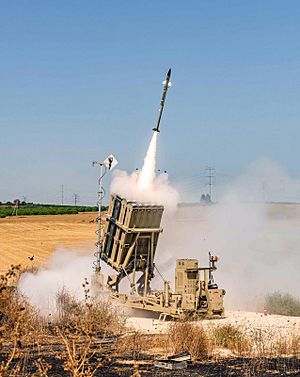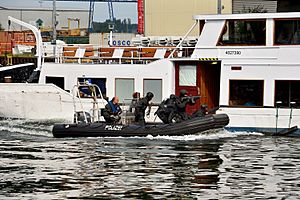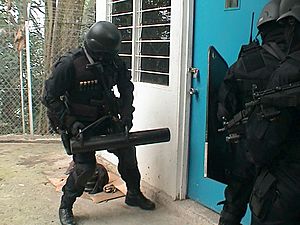Counterterrorism facts for kids
Counterterrorism is about the ways governments, police, businesses, and intelligence groups work to stop or prevent terrorism. It includes special practices, military strategies, and techniques. The main goal of counterterrorism is to defeat terrorist groups and break up their networks.
Sometimes, if terrorism is part of a bigger conflict, counterterrorism might use methods similar to fighting an insurgency. For example, the United States Armed Forces has programs to help other countries deal with lawlessness or threats to their safety.
Contents
History of Counterterrorism
The first group specifically formed to fight terrorism was the Special Irish Branch of the Metropolitan Police in the UK. It later became known as the Special Branch and dealt with more than just Irish terrorism. Other police forces around the world created similar units.
A very important moment was the creation of GSG 9 in Germany. This special police unit was formed after the 1972 Munich massacre, a tragic event where Israeli athletes were taken hostage and killed.
Counterterrorism efforts grew a lot in the late 20th century as people felt the threat of terrorism was increasing. After the September 11 attacks in 2001, many Western governments made fighting terrorism a top priority. This included working more closely with other countries and focusing on preventing attacks. Even though big attacks in developed countries get a lot of media attention, most terrorism actually happens in less developed countries.
Planning Counterterrorism Efforts
Gathering Information: Intelligence, Surveillance, and Reconnaissance
To fight terrorism effectively, governments need to understand who the terrorist groups are, why they do what they do, and how they plan their attacks. This relies heavily on good intelligence gathering.
Police and intelligence agencies often use methods like listening to communications or tracking people. New technology has made these efforts more advanced. Sometimes, intelligence gathering focuses on specific groups, which can lead to debates about privacy and civil liberties. It's often harder to find "lone wolf" terrorists because they act alone and try to stay hidden.
Getting information from inside a terrorist group is very difficult because these groups are often small and secretive. Financial tracking and listening to communications can help, but these methods must be balanced with people's right to privacy.
Laws Against Terrorism
Many countries have special laws to fight terrorism. These laws help governments take action against terrorist groups and individuals.
- United Kingdom
The UK has had counterterrorism laws for a long time, starting in 1939. These laws were updated over the years, especially after events like "the Troubles" in Northern Ireland and the September 11 attacks. Laws like the Terrorism Act 2000 and the Anti-terrorism, Crime and Security Act 2001 gave authorities more powers. These laws are regularly reviewed by an independent expert.
- United States
After the September 11 attacks, the U.S. passed the Patriot Act and created the Department of Homeland Security (DHS). The DHS brought together many agencies to coordinate efforts against terrorism and respond to disasters. There are also laws like the Posse Comitatus Act that limit how the U.S. military can be used within the country, usually requiring the President's approval.
- Australia
Australia also passed several counterterrorism laws, especially after the 2004 2004 Madrid train bombings. These laws allow police to hold suspects for up to two weeks without charge and track them electronically. Some of these laws, like the "shoot-to-kill" clause in the Australian Anti-Terrorism Act 2005, have been debated because they affect traditional freedoms.
- Israel
Israel has laws against being a member of a terrorist group or helping them. The Israeli Supreme Court has even ruled that "targeted killings" (striking specific individuals) are allowed for self-defense. In 2016, Israel passed a broad law against terrorism, setting strict punishments for terrorists.
Human Rights and Counterterrorism
One big challenge in fighting terrorism is making sure that efforts to increase security don't take away people's civil liberties or privacy. Sometimes, measures meant to improve safety can be seen as going too far or violating human rights.
Examples of these problems include holding people for a long time without trial, the risk of torture during transfers between countries, or security measures that limit people's freedoms. For instance, some countries have been criticized for arresting and holding people without proper legal process.
Many people argue that violating human rights can actually make the terrorist threat worse, not better. Human rights groups believe that protecting human rights is a key part of fighting terrorism. They suggest that treating terrorism as a crime, handled through existing laws and respecting human rights, is the best approach. International groups like Amnesty International emphasize that democratic values and human rights are essential tools in this fight.
Stopping Attacks Before They Happen
Some countries believe in stopping suspected terrorists before they can carry out an attack. This can involve capturing, killing, or disabling them. Countries like Israel, the United Kingdom, the United States, and Russia have used this approach.
Another way to prevent attacks is by questioning known or suspected terrorists to get information about their plans or other members of their group. However, there are strict rules about how these interrogations can be done to protect human rights.
Non-Military Approaches
The idea of "human security" suggests a non-military way to fight terrorism. This approach focuses on solving the basic problems that might lead to terrorism, like poverty or inequality. It involves making sure everyone has access to things like clean water, education, healthcare, food, and shelter. When people feel safe and have their basic needs met, they are less likely to be drawn to violence.
Programs that help other countries improve their internal security, called "foreign internal defense", can also involve non-military ways to fight terrorism. Studies have shown that helping countries with their governance and civil society can reduce domestic terrorism, especially when there isn't a civil conflict happening.
Military Approaches
Sometimes, countries use military force to fight terrorism, especially when terrorist groups are based in other countries. For example, the U.S. invasion of Afghanistan and the Russian invasion of Chechnya were justified this way.
However, military action doesn't always completely stop terrorism. While it can disrupt a terrorist group's operations for a while, it might not end the threat entirely. In some cases, military repression alone can lead to short-term wins but might not be successful in the long run if other solutions aren't also used.
Preparing for Attacks
Making Targets Safer
One way to prevent or reduce the damage from terrorist attacks is to make potential targets stronger and more secure. This is called "target-hardening."
For example, barriers can be placed outside important buildings to prevent car bombings. Buildings can also be designed so people can evacuate quickly. Airplane cockpits are kept locked and have reinforced doors to prevent hijackings. After the 7 July 2005 London bombings, many UK railway stations removed their garbage bins to prevent bombs from being hidden inside them.

Israel, which often faces rocket attacks, has developed advanced defenses like bomb shelters in buildings and active protection systems such as the Iron Dome. The Iron Dome can shoot down incoming rockets in the air, saving lives.
It's also important to protect industrial sites and other critical infrastructure. Terrorists could cause huge accidents by attacking chemical plants or power grids. For instance, the Northeast blackout of 2003 showed how vulnerable power grids can be.
Managing a Crisis: Command and Control
If a terrorist attack happens, different emergency services need to work together smoothly. An "incident command system" helps coordinate police, fire departments, medical teams, and other groups. This system can scale up for bigger events, like multiple attacks in one area or a national emergency.
Reducing Damage
Fire departments, along with public works and construction crews, are usually the first responders to deal with the physical damage after an attack.
Local Security
Local police play a crucial role in securing the area of an incident and controlling the situation. Special police units, often called police tactical units, can carry out operations against terrorists, especially in situations like shootouts or hostage takings.
Medical Help
Emergency medical services (EMS) are vital for treating and transporting injured people to hospitals. Hospitals often have special plans for handling many casualties at once. Public health agencies also help identify and deal with potential biological, chemical, or radiological attacks.
Special Tactical Units
Many countries have special counterterrorist units. These are highly trained police or military units whose job is to directly deal with terrorist threats. They work to prevent attacks, rescue hostages, and respond to ongoing incidents.
These units are trained in special military tactics and are equipped for close-quarters combat, focusing on being stealthy and completing their missions with as few injuries as possible. They include assault teams, snipers, bomb disposal experts, and intelligence officers. They are especially effective in longer situations like hostage crises, but shorter incidents like assassinations are harder to stop due to less warning time.
Most tactical counterterrorism operations are handled by police or intelligence agencies. In some countries, the military might be called in as a last resort, especially if the situation is beyond what police can handle.
Examples of Counterterrorist Operations
Here are some famous counterterrorist operations:
| Incident | Main Location | Counterterrorist Force | Results |
|---|---|---|---|
| Sabena Flight 571 (1972) | Tel Aviv-Lod International Airport, Israel | Sayeret Matkal (Israeli special forces) | Hostages rescued; hijackers killed or captured. |
| Lufthansa Flight 181 (1977) | Mogadishu International Airport, Somalia | GSG 9 (German special police) | Hostages rescued; hijackers killed or captured. |
| Iranian Embassy siege (1980) | London, UK | Special Air Service (British special forces) | Hostages rescued; most kidnappers killed. |
| Operation Entebbe (1976) | Entebbe Airport, Uganda | Sayeret Matkal (Israeli special forces) | Most hostages rescued; hijackers and some Ugandan soldiers killed. |
| Moscow theater hostage crisis (2002) | Moscow, Russia | Spetsnaz (Russian special forces) | Most hostages freed; all kidnappers killed. |
| Beslan school siege (2004) | Beslan, Russia | Russian special forces and police | Many hostages and rescuers killed; kidnappers killed or captured. |
| 2008 Mumbai attacks (2008) | Multiple locations in Mumbai, India | National Security Guard (Indian special forces), police | Many civilians and officers killed; most attackers killed, one captured. |
Designing Counterterrorist Systems
Creating effective counterterrorism systems is a huge task. It involves using technology to constantly gather intelligence and plan actions. A big challenge is that the future of terrorism is uncertain – it's hard to predict when, where, or what kind of attacks might happen. So, these systems need to be flexible and able to adapt as new information becomes available.
Law Enforcement's Role
In many countries, police agencies play a key role in preventing and responding to terror attacks. After 9/11, many police forces around the world started focusing more on counterterrorism.
American Law Enforcement
In the U.S., agencies like the Department of Justice (DOJ) and the Department of Homeland Security (DHS) are at the forefront of fighting terrorism. This includes groups like the Border Patrol, the Secret Service, the Coast Guard, and the FBI. State and local police also work closely with these federal agencies. While some question how much local police can help, others believe their role in community engagement is important for counterterrorism.
It's hard to measure exactly how effective law enforcement's counterterrorism efforts are because terrorist attacks are rare events. This makes it difficult to use traditional crime statistics like arrest rates to judge success.
Military's Role

Within the military, counterterrorism is often part of "irregular warfare". Most military organizations don't have units solely dedicated to counterterrorism. Instead, special forces units often take on these tasks.
In some countries, laws prevent the military from operating within their own borders for law enforcement purposes. In these cases, police usually handle domestic counterterrorism. If a situation becomes too big for the police, like the Iranian Embassy siege in the UK, responsibility might be formally handed over to military special forces.
Images for kids
-
A United States Coast Guard vessel patrolling in the Upper New York Bay to prevent terrorism.
-
Yamam, one of Israel's counterterrorism units.
-
Transparent garbage bin at Central Station in Sydney. Clear bins help police check for bombs.
-
U.S. Marines in Afghanistan.
-
FBI Hostage Rescue Team agents during a training exercise.
See also
 In Spanish: Contraterrorismo para niños
In Spanish: Contraterrorismo para niños
- Civil defense
- Counterinsurgency
- Explosive detection
- Informant
- Infrastructure security
- Manhunt (law enforcement)
- Manhunt (military)
- Paramilitary
- Security increase
- Special Activities Division, Central Intelligence Agency
- Targeted killing









